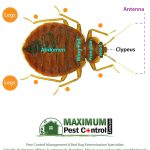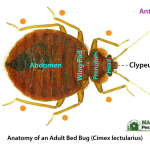
How to Identify BedBugs and Keep Them Out
Cases of live bedbugs infestations have increased steadily in Toronto Canada, especially in The Hamilton and Mississauga Areas in the past decade. Bed bugs are creepy blood sucking crawlies that depend exclusively on the blood of warm-blooded humans or specific animals to survive. Though they prefer feeding on human blood, bed bugs have not been shown to spread diseases. However, infestation of bedbugs bites cause a lot of discomfort, itchiness, and inflammation. This itchiness causes a lack of sleep and excessive scratching, often leading to secondary skin infections in time.
Bedbug infestations are also linked to negative psychological effects such as anxiety, stress, paranoia, and social withdrawal. These annoying tiny pests are notoriously difficult to control because they multiply rapidly. One female bedbug produces about 1-5 eggs daily and up to 500 eggs in her lifetime. That’s why you need to contact Maximum pest control trained technicians the experts to get rid of bedbugs upon the first sign of an infestation. Maximum Pest Control Services will inspect your home and utilize the latest technology to completely get rid of bedbugs and their eggs.
What Are Bedbugs? How to Identify Bedbugs?
Looking for information on Bedbugs? They are reddish small, flat pests measuring about 5mm long (nearly the size of an apple seed) before feeding. These critters have an oval shape with a reddish-brown color and no wings. After a blood meal, however, their bodies become swollen and get a dark red color. Though they don’t fly or jump, bed bugs can crawl at impressive speed.
Bed bugs are typically considered to be nocturnal because they mainly appear at night to take a blood meal from a sleeping host. But if they are hungry, bed bugs will also appear during the day to forage for a host. That said, it’s important to note that they can survive for up to 5 months without a blood meal. Their small bodies allow them to hide in the narrow cracks and crevices of walls, floors, furniture and side of the beds. Baby bed bugs are much smaller than adults and have a white color that makes them even harder to spot.
Their eggs are very small (about the size of a dust particle) with a whitish or semi-transparent color. The eggs are barely visible without the help of a magnifying glass. A female bed bug produces about one egg per day. Bedbug eggs hatch in about 10 days, and the bed bug nymph sheds its skin (molts) 5 times before becoming an adult. Under ideal conditions (for instance, your home), bed bugs will develop from eggs to reproductive adults in as little as 30 days!
How Do Bedbugs Get into My Home?
Where do bedbugs come from? Unfortunately, bedbugs travel can get into your home in many ways. Contrary to popular belief, bedbugs are not attracted to dirt and filth. Instead, these dreaded pests are attracted to your body heat and the carbon dioxide you exhale because they feed on human blood. Here are ways that bed bugs get into homes:
- Bed bugs can hitch a ride on your clothes, for instance, if you use public transportation with infested seats with many people reporting seeing them on the bus.
- You can unknowingly bring bed bugs home on your luggage or backpack after spending a night in an infested hotel, that’s why you need to check the room before taking over the room.
- Bed bugs also move between rooms in multi-unit buildings such as hotels and apartments very easily within the outlets and under the room base structure.
Where Bedbugs Hide Secrets Spots in The House?
When bedbugs infest your home, they prefer to stay hidden in areas that easily go undetected. Their small bodies allow them to stay concealed in narrow cracks and crevices so that you can barely see or kill them. However, bed bugs don’t live far from their hosts. That’s why you’ll often find them in the bottom box springs, mattress seams, bed frames, and headboards, where they can easily access you as blood meal. When the infestation becomes severe, bed bugs will spread to other areas in your home, such as:
- Upholstery cushions
- Behind wall hangings
- Cardboard boxes
- Beneath cracked wall paintings and wallpapers
- Underneath carpets
- Behind blindfolds and curtains
- In stuffed animals, backpacks, and handbags
-
In electrical outlets and appliances such as TV screens and laptops.
Signs of A Bedbugs Infestation in My Home
Waking up with small, red, and itchy bites may indicate a bed bug problem. However, bed bug bites often resemble other insect bites. Hence, bites acquired at night could point to other pest issues. If you suspect a bed bug problem, keep an eye out for the following signs:
- Bedbug bites usually appear as clusters in a small area of your exposed skin, such as the face, neck, and hands. Besides being itchy, bed bug bites can also become inflamed. However, not every victim reacts to bed bug bites by experiencing these symptoms.
- Unexplained blood spots on your sheets and pillowcases
- Bedbug skin, egg shells, and droppings in mattress seams. Their droppings consist of ingested blood; hence they appear as rust-colored or black spots on your bedclothes, mattress, and walls.
- A pungent musty smell that is often likened to berries may be a sign of a full-blown infestation.
How Do I Keep Bed Bugs Out?
Here are effective tips to keep bed bugs out of your home:
- Clean your home and get rid of clutter to reduce the number of hiding spots. A cluttered home, especially the bedroom, offers many places for bed bugs to hide, making it hard to find them as well as control them.
- Regularly vacuum your home while paying attention to places where bed bugs can hide, such as carpets, cracks on the floor, bed frames, and mattress seams. Ensure to empty the vacuum bag and dispose of it at a safe distance outside your home.
- Wash your bed clothing, including sheets, blankets, and pillowcases, on high heat. Then dry them on the highest setting for about 30 minutes. If you already have an active bed bug infestation, high temperatures above 122°F will help kill the bugs and their eggs.
- Don’t bring second-hand items into your home unless they are inspected and treated to eliminate bed bugs and cockroaches infestation. Second-hand clothes should be washed and dried at high heat, and second-hand furniture should be vacuumed thoroughly before being brought indoors.
- Fix damaged wallpapers and cracked paint to reduce possible bed bug hiding points.
Consider Engaging Maximum Exterminators The Bedbugs Control Experts
The above tips will help keep bed bugs out of your home. However, they are notoriously difficult to control due to their ability to hitchhike on clothes and luggage. Bedbugs small size allows them to hide in narrow cracks and crevices and go unnoticed for a long time. If bed bugs are giving you sleepless nights, call a pest control expert exterminator immediately. The technicians at Maximum pest control services will help you get rid of them for good and prevent chances of re-infestations. Maximum Pest Control Services certified exterminators are licensed to offer effective bedbug solutions throughout Greater Toronto Area, Oakville, Burlington, Hamilton, Scarborough, Milton and Mississauga Ontario. Contact Us Today (905) 582-5502.



